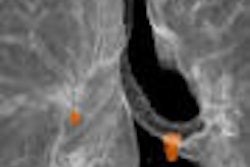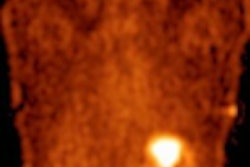TORONTO - Head and neck cancer is the fifth most common cancer worldwide and the most common neoplasm in Central Asia, and accounts for 2.8% of all malignancies in the U.S., according to presentations this week at the Society of Nuclear Medicine (SNM) conference. Multimodality management of head and neck cancer patients is now the modus operandi in most medical centers.
"It is important to understand the sensitivity and specificity of FDG-PET and other conventional imaging modalities in identification of the degree of nodal involvement," said Dr. David Archibald of the Mayo Clinic in Rochester, MN, who presented the results of a multidisciplinary study from Mayo's departments of otorhinolaryngology and radiology, and the department of otolaryngology at the University of Maryland School of Medicine in Baltimore.
According to Archibald, an important prognostic indicator in patients with head and neck cancer is the presence or absence of cervical metastasis. The researchers set out to retrospectively evaluate the sensitivity and specificity of FDG-PET in comparison with CT, MR, and a physical examination for the initial staging of primary tumors of the head.
"At present, neck dissection with histological examination is the most dependable staging procedure," he said. "A noninvasive procedure that provides accurate neck staging is highly desired."
The group identified 1,214 patients from its PET center database who had undergone an FDG-PET scan within the past four years. The team then defined a further subset of 120 patients who had consented to be available for research, had no prior radiotherapy, had undergone a prior CT or MR exam for staging, were being evaluated for initial staging of new disease, and had planned to undergo a neck dissection.
From this group, Archibald said that 55 patients had CT studies and 26 had MR exams. The mean age of the group was 58 years, and was comprised of 78% males and 22% females.
"Sensitivity and specificity for nodal disease for each test were determined with 95% confidence intervals," he said. "Tissue confirmation was used as the gold standard of disease."
The researchers reported that the sensitivity and specificity for nodal involvement by modality were 70% and 74%, respectively, for the physical exam; 90% and 47% for CT; 91% and 53% for MR; and 88% and 70% for FDG-PET. The total number of sampled lymph nodes was 5,497 and mean number per patient was 45.8. The average percentage of histologically positive nodes was 6.5%.
"There were 98 patients who had a PET/CT exam and 22 who had just a PET study," Archibald said. "We found no statistical difference in sensitivity or specificity in those groups."
The majority of patients, 99 or 82.5%, had squamous cell carcinoma, five (4.2%) had adenocarcinoma, four (3.3%) were benign, and the other 18 patients had various other pathology types, according to Archibald.
"FDG-PET, CT, and MRI had similar sensitivities in detecting nodal disease in HNC [head and neck cancer]," he said. "FDG-PET and the physical exam had superior specificity compared with CT and MR, but further studies with an increased sample size are necessary to improve the confidence intervals."
By Jonathan S. Batchelor
AuntMinnie.com staff writer
June 23, 2005
Related Reading
PET/CT demonstrates staging strength over PET, CT, and PET plus CT, March 27, 2005
PET improves on CT in staging esophageal cancer, February 3, 2005
PET and CT combination helps spot recurrent cancer, December 30, 2004
PET/CT improves detection of metastatic colorectal cancer, December 16, 2004
MR, PET/CT show low sensitivity for melanoma, November 30, 2004
Copyright © 2005 AuntMinnie.com




















